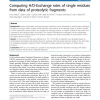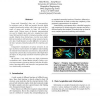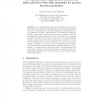508 search results - page 59 / 102 » A graphical model for protein secondary structure prediction |
ICML
2007
IEEE
14 years 10 months ago
2007
IEEE
We propose a class of graphical models appropriate for structure prediction problems where the model structure is a function of the output structure. Incremental Sigmoid Belief Ne...
BMCBI
2010
13 years 9 months ago
2010
Background: Protein conformation and protein/protein interaction can be elucidated by solution-phase Hydrogen/ Deuterium exchange (sHDX) coupled to high-resolution mass analysis o...
BIBE
2004
IEEE
14 years 28 days ago
2004
IEEE
Large-scale biomedical data sets of macromolecular structures such as DNA and proteins describe highly complex biomolecular entities which often consist of thousands of atoms and ...
ISMB
2000
13 years 10 months ago
2000
Knowing the number of residue contacts in a protein is crucial for deriving constraints useful in modeling protein folding, protein structure, and/or scoring remote homology searc...
MCS
2010
Springer
14 years 1 months ago
2010
Springer
Abstract. The computational genome-wide annotation of gene functions requires the prediction of hierarchically structured functional classes and can be formalized as a multiclass, ...




